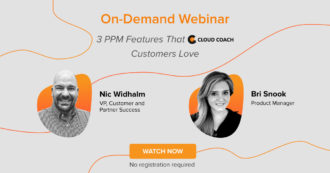 Webinar
Webinar
- Solutions
- Customer Onboarding
- Customer Success
- Professional Services Automation
- Project Management
- Project Portfolio Management
-
Solutions
-
Features
- Why Cloud Coach
- Customers
-
Resources

Measuring customer success can be done in various ways, depending on the goals and objectives of your business. One way is to measure customer satisfaction, which can be done through surveys or interviews. Another way is to measure customer loyalty, which can be done by tracking customer repeat purchases or customer retention rates. Additionally, you can measure customer success by tracking customer engagement and usage, such as through online analytics or measuring the number of people using your product or service.
Finally, it is important to track customer success metrics that are specific to your business, such as the number of sales generated or the total number of customers. By tracking these metrics, you can gain a better understanding of how successful your customers are and how you can improve their experience.
Having defined what customer success means to your customers and created a strategy that encourages them to succeed, now you need a way to measure your efforts.
Below, we’ll go into further detail around the three main areas your business can take measurements of success from—namely, direct feedback, user engagement, and social listening/monitoring.
Direct feedback
The first, and arguably the most important way to measure success is through direct feedback. Just as Małgorzata mentioned in her earlier quote “every piece of feedback from our customers is worth its weight in gold”. Hearing directly from your customers is by far the most solid indicator of whether or not they’re happy and succeeding with your product or service.
The challenge here is that not all of your customers have the time or want to go through the effort of providing feedback—unless they get a really good, or really bad experience.
According to research from Bright Local, 67% will consider leaving a review for a positive experience, while 40% will consider leaving a review for a negative experience. The key here is to provide such a great experience that your customers feel almost compelled to talk about it.
That being said, you can also make it as easy as possible for them to provide direct feedback. One way to get simple quantitative feedback is to periodically ask for a “star” rating or another Likert scale for quick and easy responses. However, if you want more in-depth information, you’ll likely want to do a CSAT (customer satisfaction) survey.
According to Survey Monkey (an online survey tool business), there are a few best practices to follow to get the most out of your surveys:
- Keep it short. Too long and you’re customers aren’t likely to finish the survey.
- Only ask questions that matter for your goals. In this case, it wouldn’t be wise to ask the customer where they heard about your business if the goal is to measure their satisfaction or success outcomes.
- Leave open-ended questions towards the end. Having your shorter, multiple-choice, yes/no, or scale-based questions at the start help to create a sense of progress, whereas asking for long-winded answers upfront might be intimidating.
- Avoid leading or loaded questions. To get honest feedback (which is more helpful for your business), you want to avoid asking questions in a way that influences the customers’ answers.
- Avoid making assumptions. It can be easy to assume that your customer knows everything about your product or service, or the words your business uses to describe them—but they’re likely not. Use simple language and ask for specificity where you need it.
As mentioned, not all of your customers are going to feel inclined or able to complete a more in-depth survey—anything above a 50% completion rate is generally considered excellent. However, you can try to encourage more completions by offering your customers a bonus for doing so, e.g. a discount or freebie.
ADDITIONAL LINKS
User engagement
The next easier and more important way of measuring customer success is user engagement. This was briefly discussed in the “best strategies” section of this guide, but here we’ll dive in a little deeper.
In that section, we showed that useful user engagement can happen in various channels:
- Social media
- Website page visits/logins
- Email opens/responses
- Internal data from web/app feature usage
We also mentioned how there are a few main measurements you can use to categorize data you gather, including:
- Acquisition channel engagement
- Feature usage engagement
- Customer engagement score
So let’s break those down further.
Acquisition Channel Engagement
Your acquisition channels are the “bottom-funnel” touch points in your customer journey designed to convince your customers to make that purchase or sign up. These touch points include ads, specific email sequences, and your website to name a few.
The main reason you want to be tracking your acquisition channel engagement is to determine your Customer Acquisition Costs (CAC) to Life Time Value (LTV) ratio—which you can do by using the following formulas:
LTV = Average Monthly Revenue per Customer x Customer Lifetime in Months
Or
Average Monthly Revenue per Customer / Monthly Churn
Or
Average Order Value x Number of Repeat Sales x Average Retention in Months
CAC = (Cost of Sales + Cost of Marketing) / New Customer Acquired
From there, you can figure out your LTV:CAC ratio by simply dividing your LTV by your CAC.
Each acquisition channel will have its own LTV:CAC ratio, and you want the ratio to be higher for LTV and lower for CAC. When the lifetime value is high, that’s a strong indicator that the channel has a good amount of engagement.
However, keep critically evaluating your channels, as some (such as ads) might have high CAC and would be worth adjusting to aim for lower CAC to LTV.
Feature Usage Engagement
This measurement is a little less complicated than acquisition channel engagement, as there is less math involved.
The idea of monitoring feature usage engagement relies on adequate data collection from your customers—but is mostly only applicable to SaaS/subscription-based service businesses. Therefore it’s important to remember to have data collection for this purpose built into your digital product or service or find a tool that helps you do it.
The purpose of monitoring feature usage is similar to why physical stores typically monitor foot traffic in-store—it tells you what your customers are more drawn to, and what they get the most value (and success) from.
Armed with the knowledge of which features your customers use the most, you can decide where to pour your marketing efforts as well as development opportunities, and if there are any features worth removing.
Customer Engagement Score
Using a customer engagement score metric does require some preparation but once the initial setup is complete, it’s a great metric to use to help get an overall picture of each customer’s level of engagement.
To set up a customer engagement score, follow these steps:
-
- Identify the key events in your customers’ journeys that involve engagement with the product or service.
E.g. signing up is just the beginning, if your business is accounting software, setting up and sending an invoice would be an engagement event. - Use event tracking.
Using analytics (whether in-house or using an external tool), you can define and tag these key events so that when a customer triggers an event the data logs into your tool.
- Identify the key events in your customers’ journeys that involve engagement with the product or service.
- Assign a score to each event.
Some events are more important than others and are greater indicators of customer success or engagement. For example, linking a bank account to the accounting software is a little less important than actively sending invoices.
Decide what events are more important and assign a score from 1-10 to them. From there, track the number of times a customer triggered each event.
When you have your event score and frequency, you can calculate the event value, which is simply the score x frequency (which can be narrowed further by limiting the period of measurement). - Calculate engagement score.
For each user, you can then calculate the engagement score simply by adding up the event values each user triggers over a specific amount of time. It’s worth adding here, some tools help you calculate customer engagement scores automatically, such as Userpilot. However, these are the steps you can take manually if you don’t want to use a tool.
These are general, encompassing methods of measuring user engagement and can be used all together to help build a bigger picture of your customers’ use of your product or service (and if they are successful at using it).
Social listening/monitoring
The last method of measuring customer success (on this list) is by using social listening/monitoring. The main reason you want to use social listening is that while customers might not want to share detailed feedback directly with your brand, they might still be talking about your business online.
Customers might be recommending your product or services to others who might need them, but they can also have reached the advocacy stage of their customer journey and are talking positively about your brand in general.
Of course, the main places you’ll need to look first are social media platforms (even ones you don’t have an account on). The main ones are Twitter, Facebook, Instagram, and TikTok—but don’t count out other popular sites like Reddit and Quora.
The idea is that you’re looking out for customers, or potential customers, that mention your brand in their content—then looking at the general sentiment (positive or negative). Positive sentiment would indicate customer success, while negative would mean the opposite.
In instances of negative sentiment, you can use the opportunity to address the issue(s) the customer has brought up. In positive instances, you can use those moments to thank the customer and share their mention across to your profile (with permission) as user-generated content.
You can do this yourself manually, but there are tools available that find mentions of your brand for you, such as Brand Mentions and Brand Watch.
Helpful Resources
See Cloud Coach In Action
We’d be happy to provide a bespoke 1:1 demo on how Cloud Coach can benefit for your business.























